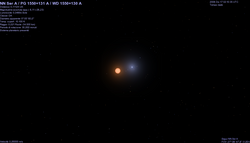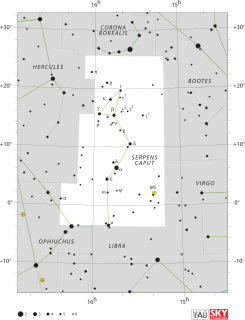
Serpens is a constellation in the northern celestial hemisphere. One of the 48 constellations listed by the 2nd-century astronomer Ptolemy, it remains one of the 88 modern constellations designated by the International Astronomical Union. It is unique among the modern constellations in being split into two non-contiguous parts, Serpens Caput to the west and Serpens Cauda to the east. Between these two halves lies the constellation of Ophiuchus, the "Serpent-Bearer". In figurative representations, the body of the serpent is represented as passing behind Ophiuchus between Mu Serpentis in Serpens Caput and Nu Serpentis in Serpens Cauda.

ι Serpentis, Latinized as Iota Serpentis and abbreviated Iot Ser, is a triple star system in the constellation Serpens, in its head. It is approximately 190 light years from Earth.

DT Virginis, also known as Ross 458, is a binary star system in the constellation of Virgo. It has an apparent visual magnitude of 9.79 and is located at a distance of 37.6 light-years from the Sun. Both of the stars are low-mass red dwarfs with at least one of them being a flare star. This binary system has a circumbinary sub-stellar companion.

HW Virginis, abbreviated HW Vir, is an eclipsing binary system, approximately 563 light-years away based on the parallax measured by the Gaia spacecraft, in the constellation of Virgo. The system comprises an eclipsing B-type subdwarf star and red dwarf star. The two stars orbit each other every 0.116795 days.

A circumbinary planet is a planet that orbits two stars instead of one. The two stars orbit each other in a binary star system, while the planet typically orbits farther from the center of the system than either of the two stars, although planets in stable orbits around one of the two stars in a binary are known. Studies in 2013 showed that there is a strong hint that the planet and stars originate from a single disk.

QS Virginis is an eclipsing binary system approximately 163 light-years away from the Sun, forming a cataclysmic variable. The system comprises an eclipsing white dwarf and red dwarf that orbit each other every 3.37 hours.

HU Aquarii is an eclipsing binary system approximately 620 light-years away from the Sun, forming a cataclysmic variable of AM Herculis-type. The two stars orbit each other every 2.08 hours and the ultra-short binary system includes an eclipsing white dwarf and red dwarf.
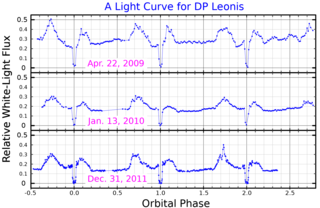
DP Leonis is binary star system in the equatorial constellation of Leo. It is a variable star that ranges in apparent visual magnitude from 17.5 down to 19. The system is located at a distance of approximately 990 light-years from the Sun based on parallax. It is a cataclysmic variable star of the AM Herculis-type also known as polars. The system comprises an eclipsing white dwarf and red dwarf in tight orbit and an extrasolar planet. This eclipsing variable was discovered by P. Biermann and associates in 1982 as the optical counterpart to the EINSTEIN X-ray source E1114+182.
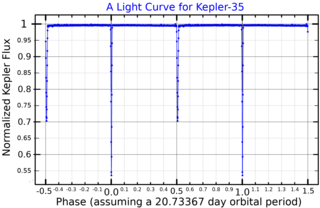
Kepler-35 is a binary star system in the constellation of Cygnus. These stars, called Kepler-35A and Kepler-35B have masses of 89% and 81% solar masses respectively, and both are assumed to be of spectral class G. They are separated by 0.176 AU, and complete an eccentric orbit around a common center of mass every 20.73 days.
PH1b, or by its NASA designation Kepler-64b, is an extrasolar planet found in a circumbinary orbit in the quadruple star system Kepler-64. The planet was discovered by two amateur astronomers from the Planet Hunters project of amateur astronomers using data from the Kepler space telescope with assistance of a Yale University team of international astronomers. The discovery was announced on 15 October 2012. It is the first known transiting planet in a quadruple star system, first known circumbinary planet in a quadruple star system, and the first planet in a quadruple star system found. It was the first confirmed planet discovered by PlanetHunters.org. An independent and nearly simultaneous detection was also reported from a revision of Kepler space telescope data using a transit detection algorithm.

RR Caeli is an eclipsing binary star in the constellation Caelum. It is 69 light years from Earth.
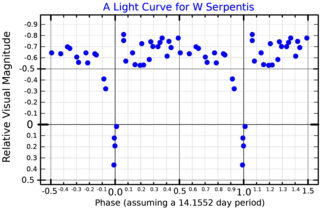
W Serpentis is an eclipsing binary star in the constellation Serpens. It is always too faint to be seen with the naked eye, varying between apparent magnitudes 8.42 and 10.2 with a period of just over 14 days. This is mainly due to eclipses; however, variations in its period indicate there are some innate changes in luminosity of one or both component stars as they interact with each other, and it has been difficult to disentangle the light to determine their nature. The period is increasing by 14 seconds a year, indicating that a massive amount of material is being transferred from the larger fainter star to the smaller brighter one.
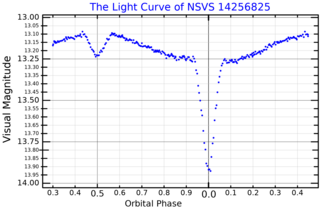
NSVS 14256825, also known as V1828 Aquilae, is an eclipsing binary system in the constellation of Aquila. The system comprises a subdwarf OB star and red dwarf star. The two stars orbit each other every 2.648976 hours. Based on the stellar parallax of the system, observed by Gaia, the system is located approximately 2,700 light-years away.
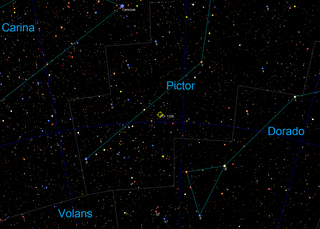
TOI 1338 is a binary star system located in the constellation Pictor, about 1,320 light-years from Earth. It is orbited by the circumbinary planet TOI 1338 b, discovered by the Transiting Exoplanet Survey Satellite (TESS).

A Post-Common Envelope Binary, PCEB or pre-cataclysmic variable is a binary consisting of a white dwarf and a main-sequence star or a brown dwarf. The star or brown dwarf shared a common envelope with the white dwarf progenitor in the red giant phase. In this scenario the star or brown dwarf loses angular momentum as it orbits within the envelope, eventually leaving a main-sequence star and white dwarf in a short-period orbit. A PCEB will continue to lose angular momentum via magnetic braking and gravitational waves and will eventually begin mass-transfer, resulting in a cataclysmic variable. While there are thousands of PCEBs known, there are only a few eclipsing PCEBs, also called ePCEBs. Even more rare are PCEBs with a brown dwarf as the secondary. A brown dwarf with a mass lower than 20 MJ might evaporate during the common envelope phase and therefore the secondary is supposed to have a mass higher than 20 MJ.

UZ Fornacis is a binary star in the constellation of Fornax. It appears exceedingly faint with a maximum apparent magnitude 17.0. Its distance, as measured by Gaia using the parallax method, is about 780 light-years.
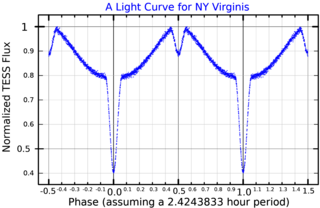
NY Virginis is a binary star about 1,940 light-years away. The primary belongs to the rare class of subdwarf B stars, being former red giants with their hydrogen envelope completely stripped by a stellar companion. The companion is a red dwarf star. The binary nature of NY Virginis was first identified in 1998, and the extremely short orbital period of 0.101016 d, together with brightness variability on the timescale of 200 seconds was noticed, resulting in the identification of the primary star as a B-type subdwarf in 2003. Under a proposed classification scheme for hot subdwarfs it would be class sdB1VII:He1. This non-standard system indicates that it is a "normal" luminosity for a hot subdwarf and that the spectrum is dominated by hydrogen rather than helium.
HD 175289 is a binary star system. Its primary star, also known as Kepler-410A, is a F-type subgiant star, orbited by the orange dwarf star Kepler-410B on a wide orbit. The companion star was discovered in 2012.
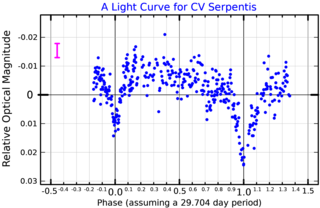
CV Serpentis is a binary star system in the equatorial constellation of Serpens. It is a detached eclipsing binary with an orbital period of 29.7 days. The system includes a Wolf–Rayet (WR) star with the identifier WR 113. The system is located at a distance of approximately 6,700 light years from the Sun based on parallax measurements. It is a member of the Serpens OB2 association of co-moving stars.

V471 Tauri is a eclipsing variable star in the constellation of Taurus. The star has a visual magnitude of 9 which makes it impossible to see with the naked eye. It is around 155 light-years away from the Solar System.
